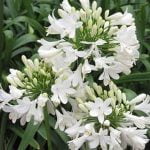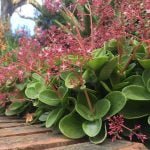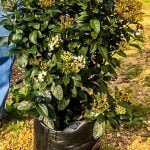Showing 97–108 of 2164 resultsSorted by popularity
-
Sale!

Succulent Combo 4 pack
Original price was: R159.99.R129.99Current price is: R129.99.Add to cartSucculent Combo 4 pack
4 amazing succulents in one combo pack!
-

Clivia Miniata Orange 4lt
R115.00Add to cartClivia Miniata Orange 4lt
Shade
Semi Shade
Water Wise
Indigenous
HardyAll our Clivias are at least 4 years old and have all flowered before.
-
Sale!

Variegated Tickey Creeper 12cm Pot
All Plants, Climbing Plants, Full Sun Plants, Ground Cover Plants, Other Climbers, Semi Shade PlantsOriginal price was: R75.00.R49.99Current price is: R49.99.Add to cartFicus Repens/Pumila Variegated 12cm Pot
Common names: Variegated Tickey Creeper, creeping figFull Sun
Shade
Evergreen
Wind Tolerant
Low WateringFast-growing, dense, lush and variegated green clinging creeper. Great solution for covering a wall or fence.
-
Sale!

Grevillea Fireworks 15cm pot
Original price was: R220.00.R139.99Current price is: R139.99.Add to cartGrevillea Fireworks 15cm pot
Full Sun
Afternoon Sun
Low Watering
Drought Tolerant
Evergreen
Insect, Bird and Bee attractions -
Sale!

Agapanthus Medium White 15cm Pot
Original price was: R85.00.R64.99Current price is: R64.99.Add to cartAgapanthus Medium White 15cm Pot
Full Sun
Semi Shade
Low Watering
Evergreen
Indigenous
Wind Tolerant -

Impatiens 6 Pack Tray
R57.50Select options This product has multiple variants. The options may be chosen on the product pageImpatiens 6 Pack Tray
-

-
Sale!

Protea White Ruby 15cm Pot
Original price was: R350.00.R149.99Current price is: R149.99.Add to cartProtea White Ruby 15cm Pot
Full Sun
Afternoon Sun
Low Watering Once Established
Drought Tolerant
Indigenous
Evergreen -
Sale!

Dodonaea Viscosa Purpurea 40lt
Original price was: R1,250.00.R895.00Current price is: R895.00.Add to cartDodonaea Viscosa Purpurea 40lt
Common Names: Purple Hop Bush, Sand OliveFull Sun
Semi Shade
Hedging Plant
Low Watering
Wind Tolerant
EvergreenDodonaea viscosa Purpurea, commonly known as Purple Hop Bush, is a cultivar of the Dodonaea viscosa plant native to South Africa. It is a shrub that belongs to the Sapindaceae family and is known for its attractive purple foliage.
Appearance: Purple Hop Bush is a compact evergreen shrub that typically grows to a height of 2-3 meters and spreads about the same width. Its most distinctive feature is its purple or burgundy-coloured leaves, which provide an eye-catching contrast in the landscape.
Foliage: The foliage consists of small, lance-shaped leaves that are arranged alternately along the stems. The leaves are typically a dark purple colour, although the intensity can vary depending on factors such as light exposure and temperature.
Flowers: Inconspicuous flowers are produced on Purple Hop Bush, and they are generally small and greenish-yellow in colour. The flowers are not the main ornamental feature of this plant; rather, it is primarily grown for its attractive foliage.
Growth Requirements: Purple Hop Bush thrives in full sun to partial shade. It is relatively drought-tolerant and can adapt to a range of soil types, including sandy, loamy, and clay soils. It is also known to be quite resilient and can withstand harsh conditions, including coastal areas with salt spray.
Uses: Dodonaea viscosa Purpurea is commonly used in landscaping as an ornamental shrub. Its striking purple foliage adds colour and visual interest to gardens, borders, and hedges. It can also be pruned and shaped to create formal or informal hedges. Additionally, Purple Hop Bush is known to attract birds and butterflies, making it a popular choice for wildlife gardens.
Propagation: This cultivar can be propagated through seeds or cuttings. Seeds can be sown directly into the ground or started indoors and transplanted later. Softwood cuttings taken in spring or semi-hardwood cuttings taken in summer have a good chance of rooting successfully.
-
Sale!

PomPom Tree 20lt
Original price was: R650.00.R465.00Current price is: R465.00.Add to cartDais Cotinifolia 20lt
Common name: PomPom TreeFull Sun
Medium Watering
Indigenous
Loses leaves during winter in Cape Town for a short time if any.Dais cotinifolia, commonly known as the Pompon Tree or Pompom Tree, is a flowering tree native to southern Africa. It is a member of the Thymelaeaceae family. This tree is widely cultivated for its attractive appearance and showy flowers.
Appearance: The Pompon Tree is a deciduous tree that can reach a height of 6-10 meters (20-30 feet) or even more. It has a spreading crown with branches that form a rounded shape.
Leaves: The leaves of Dais cotinifolia are large, soft, and somewhat reminiscent of Cotinus coggygria (Smoke Bush), which is why the specific epithet “cotinifolia” is used. The leaves are ovate, velvety, and have a bluish-green colour.
Flowers: One of the main attractions of the Pompon Tree is its profusion of beautiful, pompon-like flowers. The flowers are small, tubular, and are arranged in dense, rounded clusters. The colour of the flowers varies and can be shades of pink, mauve, or lavender, giving the tree a stunning display during its flowering season.
Flowering Season: Dais cotinifolia typically blooms during late spring to early summer, depending on the region and climate.
Growth Requirements: The Pompon Tree thrives in full sun or partial shade and prefers well-draining soil. It is relatively drought-tolerant once established but will benefit from regular watering during dry periods, especially when young. It is a subtropical tree and may not tolerate frost well.
Landscape Use: Due to its attractive foliage and eye-catching flowers, Dais cotinifolia is often used as an ornamental tree in gardens, parks, and landscapes where its beauty can be appreciated.
-

Viburnum Tinus Lucidum 20lt
R495.00Add to cartViburnum Tinus Lucidum 20lt
Approx 1.2m Tall
Full Sun
Wind Tolerant
Low Watering
EvergreenDark green, shiny-leaved shrub growing up to 4m in height with delicate, white flowers in Spring and Summer. Can form a nice hedge!
-
Sale!

Viburnum Tinus Lucidum 10lt
Original price was: R295.00.R225.00Current price is: R225.00.Add to cartViburnum Tinus Lucidum 10lt
Full Sun
Wind Tolerant
Low Watering
EvergreenDark green, shiny-leaved shrub growing up to 4m in height with delicate, white flowers in Spring and Summer. Can form a nice hedge!
